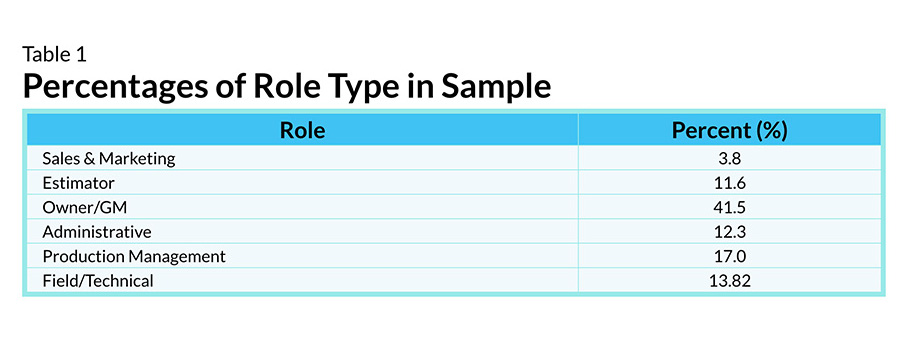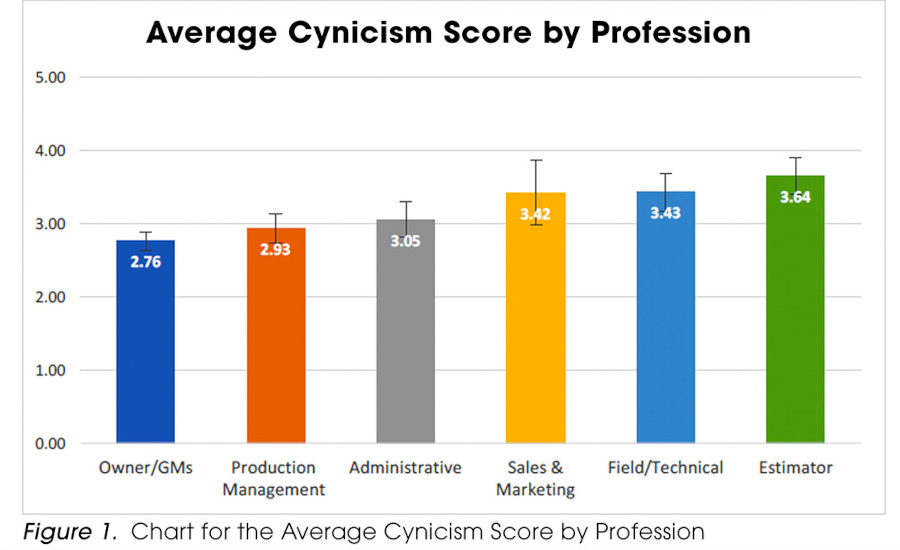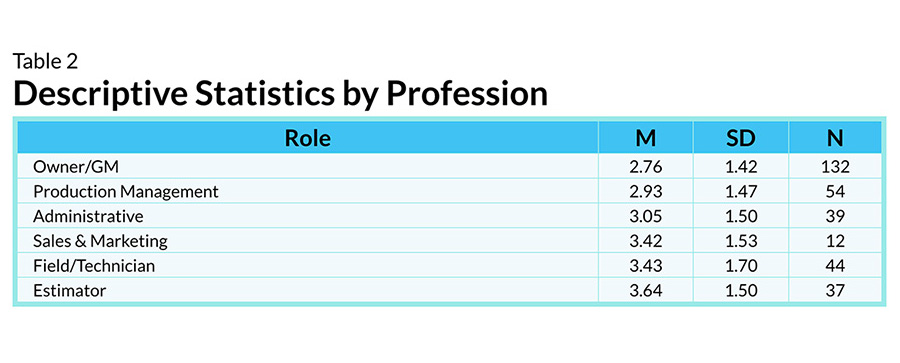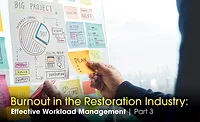Project Estimators in Restoration: Managing Cynicism

Disaster restoration estimators operate in an inherently stressful niche of the construction industry. Their work often demands being on call and working long hours under stressful and dangerous conditions following fires, floods, earthquakes, hurricanes, tornadoes, and a variety of other events that are catastrophic to structures. The purpose of this article is to explore findings from a recent study (Avila, Rapp, & Dunbar, 2021) that examined employee burnout in the disaster restoration industry. Among several things, the study discovered restoration estimators experience higher levels of cynicism and are more susceptible to burnout from their work than the general population and among other roles in the restoration industry. Cynicism reflects feelings of indifference and a distant attitude toward work; it represents dysfunctional coping with job strains (Maslach & Leiter, 1997).
In order to advance this work, the researchers isolated the data and conducted a t-test and analysis of variance (ANOVA) to further analyze (1) the cynicism of restoration estimators compared to the general population and (2) whether the average cynicism scores varied by position within the restoration industry. The goal was to verify the validity of the initial findings then reach out to industry leaders for thoughts on why this is happening and what can be done to mitigate the effects of cynicism for restoration industry estimators. The hope is that this article represents an unprecedented collaboration among academics and industry executives for improving the lives of restoration industry professionals.
Data Overview
In this study, the researchers used the Maslach Burnout Inventory (MBI) and the Areas of Worklife Survey (AWS) to investigate factors contributing to burnout for professionals in the disaster restoration industry. Two additional questionnaires were developed to record participant demographic information and whether participants were considering leaving their jobs (turnover intentions). The 2018-2019 survey data (Avila & Rapp, 2019) were used for this project. A total of 522 individual responded to the 2018-2019 survey; however, if a respondent did not complete both the Maslach Burnout Inventory (MBI) and Areas of Worklife Survey (AWS), he or she was removed from the dataset. After the data cleaning process, the final dataset contained 318 survey respondents.
Respondents
Respondents were primarily male (79.2%). The owners/GMs accounted for 41.5% of the samples. The percentage of the respondents’ roles are as follows:

General Results and Analysis
Compared to the general population, estimators from the survey showed a significantly higher level of cynicism. Among survey respondents for this study, owner/GMs experienced the least amount of cynicism on average and Estimators experienced the most. A one-way ANOVA showed that there was a significant difference in cynicism by profession type. Specifically, the level of cynicism of estimators was significantly higher than that of owner/GMs.
Analysis 1
How cynical are restoration estimators when compared to the general population?
Procedure: A one sample t test (α = .05) was conducted with the survey results against the normative data provided in the MBI Test Manual.
Results: Estimators (M =3.64, SD = 1.50, N = 37) showed significantly higher levels of cynicism, compared to the normative data (µ = 1.74, t(36) = 7.70, p < .01.
Interpretation: The average cynicism scores of estimators are significantly different from the normative data provided in the MBI manual. Estimators who participated in the survey experienced a higher level of cynicism than the general population.
Analysis 2
Which profession in the disaster restoration industry is the most (or least) cynical?
Procedure: The average cynicism score of the six role types in the restoration industry (i.e., sales & marketing, estimator, owner/GM, administrative, production management, and field/technical) were observed in order to determine the least and most cynical professions.
Results: Figure 1 shows the average cynicism score by profession with +/- 1 standard error. Owner/GMs experienced the least amount of cynicism on average (M = 2.76, SD = 1.42, N = 132), while estimators experienced the most (M = 3.64, SD = 1.50, N = 37). See Table 2 for descriptive statistics by role type.
Interpretation: Estimators experience the most cynicism on average with owner/GMs experiencing the least. A possible explanation is due to the nature of the work involved with daily tasks – the less you deal with the public and negotiating claims, the more likely you are to feel less cynical toward the job.


Practical Analysis
One of the challenges with exploratory studies that are strictly academic is that the practical implications are often poorly addressed or another study has to be designed to explore the implications which often leaves important follow up work untouched. Unfortunately, there are also many instances in which professional perspectives from practitioners are completely left out of the conversation. In order to bridge the gap between academic research and professional practice, the authors of this article have collaborated to provide an analysis of the implications of these findings from the perspective of a practitioner. To accomplish this, Hope Folk of Restoration Personnel Source is providing her thoughts on the findings and will help us understand (1) if she believes the findings to be an accurate reflection of what she has observed among restoration industry estimators, (2) what factors she believes contribute most to cynicism amongst restoration industry estimators, (3) what restoration industry estimators can do to manage the factors that contribute to increased cynicism, and (4) what restoration companies can do to help their estimators manage the factors that she believes are contributing to increased cynicism amongst restoration industry estimators.
Hope Folk is an insurance restoration industry recruiter who has worked with more than 5,000 restoration estimators and hundreds of companies over the past eight years to fill estimator positions (among many others). Her primary objective is to create growth opportunities for her candidates and clients. This requires her to pay close attention to their needs by listening to their stories, understanding their experiences, and then working to help them achieve their goals. She takes pride in getting to know each person and helping them explore opportunities that are right for them. The approach Hope applies to accomplish these things has given her unique opportunities to learn about the challenges restoration estimators face in many markets throughout the country.
Hope’s experience makes her a special and insightful collaborator for this article. While academic research is important, it cannot stand on its own. We can only advance our understanding of what estimators experience by asking them (as we did in the survey), conducting an exhaustive analysis of that data (as we did in an academic article), and having conversations with industry executives like Hope (as we are in this article) who genuinely listen and seek to understand the stories of restoration industry professionals on a daily basis.
The following dialogue with her advances our examination of cynicism among restoration industry estimators. We hope you find it insightful and that it helps the professional lives of hard-working estimators serving customers all over the country.
Interview
Question 1: Do you think the findings from this study accurately reflect what you have observed among restoration industry estimators?
Answer 1:
Yes. The findings related to cynicism are evident in the interactions we have with candidates and in what the employers describe. While few have used the word cynicism when discussing their challenges, there is a theme of having a distant attitude toward work that emerges as we explore what is going on and why some circumstances are not working for individuals and employers. It does seem to be more prevalent among estimators in the restoration industry, particularly when the position requires the estimator to secure the loss, construct an estimate, and oversee the project through completion. While this is possible in some smaller organizations, the volume of work and/or number of projects must be reasonable to deliver quality work. A common concern for the estimator is that their name is associated with the final product. If they are unable to deliver an excellent product when the project concludes, frustration begins to escalate.
Question 2: What factors do you think contribute most to the cynicism that is experienced by restoration industry estimators?
Answer 2:
This can be very complex to examine and we probably will not be able to unpack all the intricate details, but here are some factors that have come to mind as I have given this thought in light of the study.
The estimating role varies from company to company. Some estimators sell the work and write estimates; some strictly estimate; and others sell the work, estimate it, and run it. I have seen estimators and companies experience success with each of these models so I really do not have evidence that suggests there are inherent challenges with how the role is set up. The challenges seem to stem from individual capacity, workload (and nature of the work), and overall fit.
- Individual capacity – Everyone has different capacities for managing tasks, stress, time, competing priorities, efficiency, extended travel, and similar factors. Challenges seem to emerge when individuals and employers are not communicating on these things or when there are expectations that simply cannot be met by the estimator – when their capacity is stretched or exhausted. Some individuals have reservations sharing struggles with employers and, similarly, some employers simply are not aware when it comes to understanding an individual’s capacity to do the work. There are likely many reasons why this happens, but individual capacity to do the work has often been a source of stress that has led to cynicism for many estimators I have had the opportunity to work with. Candid conversations need to happen and employers need to come alongside their estimators to help them understand their capabilities and how they can increase their capacity to do good work – regardless of how great or small their capacity may be.
- Workload (and nature of the work) – Every restoration company has their own approach to assigning workloads and determining expectations for their estimators. This factor does have a strong connection to individual capacity (above); however, it is also its own thing. It seems software, vendor programs, and best practices (among other things) have all contributed to increased workloads for most roles in most industries and has potentially contributed to increased cynicism among restoration industry estimators. Restoration estimators have not been immune to the effects of taking on more. Everything seems to be getting measured and it seems there is unprecedented pressure to do more with less for everyone – including restoration estimators. A complicating workload factor for restoration estimators is the nature of the work. There are inherent challenges that come with being on-call, managing clients that have been impacted by disaster, dealing with the emotions of clients, negotiating with adjusters, and managing performance metrics (often derived from evolving algorithms) related to their roles or determined by carriers and vendor programs. I have frequently been told by estimators that one of the big reasons they entered the profession is because they long to help people in times of catastrophe. However, working under these conditions can wear down some of the most hard-working and resilient people. These duties sometimes come with the responsibility of being deployed for up to 250 days out of the year. The estimator has the task of providing an accurate estimate under adverse conditions while striving to be empathetic in their contact with customers. Most customers are in the middle of a sensitive time involving what could be the total loss of personal property, personal possessions, heirlooms, and business assets. Estimators are called to work under this pressure for long hours, often exceeding 50 to 60-hour work weeks, for sustained periods of time. They are often staying in hotels and eating whatever food they can grab on the run. The estimating work itself is demanding, but simultaneously providing customer service, negotiating with carriers and consultants, and working to adhere to performance metrics takes additional thoroughness and emotional energy.
- Overall fit – While fit within the organization is important, it is also critical to examine fit within the industry and their respective estimating role. These things do not always line up as we might hope and restoration estimators should think in these different contexts when considering fit. Organizational fit is paramount and entire books have been devoted to this topic. However, it is also important that the industry and the work they do on a daily basis are factors they are excited about. If they are not excited about any of these things then it is important for the estimator to invest in understanding why.
Other factors I hear from estimators that seem to contribute to increased cynicism include (1) the inability to grow within a company – some companies are not strong at developing their talent; however, there are also many instances in which estimators fail or refuse to acknowledge their own shortcomings and that they are responsible for their own inability to grow within a company, (2) limited time-off or vacation time to recharge from the time that is often required in the role, and (3) altering commission structures during the course of employment.
Question 3: What can restoration industry estimators do to manage these factors that contribute to their increased cynicism?
Answer 3:
Restoration estimators need to bring a great attitude and strong work ethic to the job on a daily basis. They need to be teachable, confident, and humble. They need to be reflective and have a realistic assessment of themselves. For example, an estimator has little room to complain about workload if they are highly inefficient at managing the time and resources they are entrusted with. Delusions of adequacy can abound and estimators need to consider how effective they really are (in terms of managing the things they have immediate control over) before bringing concerns to their employers. Candid conversations with employers about workloads can be difficult if estimators are (1) not proactive in developing their individual capacities to increase their productivity, (2) unorganized, (3) toxic, (4) lazy, (5) dishonest, or (6) allow themselves to be constantly distracted by things unrelated to work throughout their day.
Restoration estimators must strive to (1) be effective, (2) be resilient, (3) improve themselves and their work continuously, and (4) bring value to the companies and customers they serve. Operating in this manner opens the door for meaningful and candid conversations related to ways they may increase their capacity, manage workload, and assess overall fit in a variety of contexts. If an estimator can consistently deliver on these things and consistently generate strong results, they are using the best recipe for success and opportunities will find them.
Question 4: What can restoration companies do to help their estimators decrease the levels of cynicism they experience working in the industry?
Answer 4:
There is a lot we could examine with this question, but I think it would be good if we discussed a few challenges surrounding the concept of change – it seems much of what we hear from estimators and companies is that trust is lost and challenges are often met in circumstances surrounding change – which we can probably draw a logical connection to cynicism. For example, when implementing new changes it is a worthwhile investment of time to address questions from teams and help them understand (1) the nature of the changes, (2) why the changes are happening, and (3) what can be done to effectively manage the changes in a practical sense. This becomes increasingly important if change in a particular area is painful or regular. We do see instances where negative changes to compensation plans leads to cynicism. Changes like this can be some of the toughest, but do not have to lead to the loss of some of your brightest talent. Be intentional and avoid making changes like this frequently or without a compelling rationale.
Restoration company leaders can start by examining themselves and their companies and make sure they understand what they are about and why (individually and for the company). They should regularly reflect on how their decisions align with what they are about and develop cultures that embrace agility, accountability, and trust. This requires a commitment to having a genuine interest in understanding and meeting the needs of their people and customers. It seems challenges flourish when these things are missed and, while we live in a world that is characterized as “constantly changing,” we do not have to constantly change everything we do. Leaders should be strategic and intentional with the things they change and help the team understand what is happening, why it is happening, and how it is helping the company advance in a positive direction. Be honest when doing this… employees are adept at sniffing out lies and become cynical when everyone is ignoring the elephant in the room.
Special Thanks
The authors wish to extend special thanks to Les Cunningham, members of Business Networks, Restoration Personnel Source, and other industry leaders who have who have graciously shared their experiences and been engaged throughout the development of the study. Thank you for the support, feedback, and valuable insight.
Looking for a reprint of this article?
From high-res PDFs to custom plaques, order your copy today!






